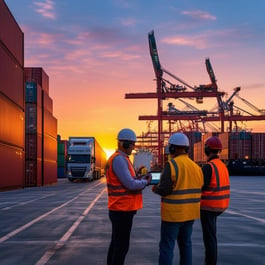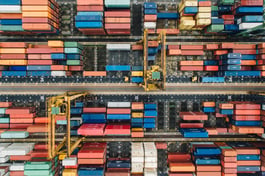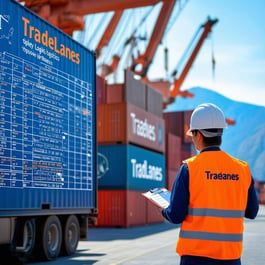Update: 2023 Research Report on Early Return Dates
The Vessel Schedule Impact Report 2023 provides critical insights into the challenges and costs associated with managing Early Return Dates (ERDs). Here are the key findings:
- Frequent ERD Changes are Costly: Exporters incur an average of $356–$361 per shipment due to last-minute ERD adjustments, including rescheduling drayage providers and storage fees.
- Data Discrepancies Persist: 41% of exporters report conflicting ERD information between carriers and terminals, leading to operational inefficiencies.
- Proactive Management Reduces Costs: Exporters using real-time data platforms experienced 25% fewer disruptions and minimized disputes over ERD-related fees.
- High Manual Workloads Remain a Challenge: Exporters relying on manual processes for ERD validation spend an additional 10–15 hours per week on schedule management.
These findings highlight the importance of adopting automated solutions like TradeLanes to streamline ERD management, reduce costs, and save time.

What Are Early Return Dates?
An Early Return Date (ERD) is the first date exporters can return containers to a terminal or depot for shipment. Adhering to ERDs ensures smooth operations and avoids costly fees.
A CY Cutoff (Container Yard Cutoff) is the last date and time by which an exporter must deliver a container to a designated container yard (CY) at a port or terminal for it to be loaded onto a scheduled vessel. This deadline is critical for ensuring the container is processed, inspected, and ready for loading before the vessel departs.
The Cargo Receiving Window is the timeframe during which a port terminal or container yard (CY) accepts export containers for a scheduled vessel. It begins with the Earliest Return Date (ERD) and ends at the CY Cutoff. This window provides exporters with a specific period to deliver their containers for processing, inspection, and loading onto the vessel.
Challenges with ERDs
- Frequent Changes: ERDs can change without notice, forcing exporters to reschedule drayage providers.
- Data Discrepancies: Conflicting information between carriers and terminals creates confusion.
- Fees and Delays: Missing ERDs can result in costly storage or re-handling charges.
Managing ERD Challenges
Exporters can mitigate ERD issues by adopting these best practices:
- Centralized Data Platforms: Consolidate schedules from carriers and terminals into one reliable source.
- Real-Time Notifications: Stay ahead of schedule changes with automated alerts.
- Proactive Communication: Establish clear channels with carriers and terminals to minimize confusion.
How can TradeLanes help?
TradeLanes simplifies vessel schedule management by providing exporters with real-time updates and a single platform for all schedules. Reduce manual work and avoid costly surprises by trusting TradeLanes to handle your vessel schedules.
To participate in the 2025 Vessel Schedule Impact Report, click here Vessel Schedule Impact Survey for 2025.

Early Return Date (ERD) Nightmares and What to Do
ERD (Earliest Return Date, sometimes called Early Return Date). This simple 3-letter acronym has become a necessary evil for ocean carriers and the source of nightmares for shippers. (If you know about ERD and want to skip to the chase to help us tackle ERD issues: Sign up here to participate in an anonymous research project to minimize ERD pains.)
ERDs Change
ERDs can, and do, change. And they change far too often, from a shipper’s perspective. Worse still, they frequently changed with very little notice to the shipper.
If there is one thing that can disrupt a shipment and wreak havoc on a shipping coordinator's day, it is finding out the day before loading that the ERD was pushed out 3 days and that your window to load those 25 containers has shrunk from 5 days to 2 days.

Now, what do I do?
Now, what do I do? The warehouse or transloader is expecting to load 5 containers per day. The trucker has arranged to load the 5 containers per day. If I keep the same loading schedule, I will have extra costs - for the trucker to dray the containers to their yard, storage to hold the containers on their yard, additional daily chassis usage fees. Or, I can try to change the loading dates with the warehouse or transloader and see if the trucker can load all 25 containers in 2 days?
This may require additional dray to accomplish the work and will definitely result in a higher dray rate. Now, it becomes a cost juggling exercise.

Additional Information
Global trade coordinators and export logistics teams alike are pained. How do you explain the increase in costs to senior management? Why was the margin lower than expected on the trade? Is this just the cost of doing business? Do you accept the status quo from the lines? Do shippers deserve better? Do carriers understand the financial impact on shippers when ERD changes? Do they even really care?
At TradeLanes, our job is to remove friction from global trade. ERD is one of those frictions. We have solutions that make updating documents, managing bookings, and updating instructions to your partners as easy as 3 clicks, and are now exploring how to leverage technology and machine learning to help minimize the negative impacts of the ERD issue (i.e. - unreliable vessel schedules).

Research We Conduct on ERDs & Changing Vessel Schedules
Our first step is research to understand the scope, character and cost of the problem: we’re conducting interviews and surveys and sharing the information back with participants. If you’re willing to be interviewed and receive our findings in return, please leave us your information here.
Right now, we're conducting the Vessel Schedule Impact Survey for 2025 <---- Click that link to take the survey. All responses are anonymous.
And, if you're interested in talking with us future research, contact us at market.insights@tradelanes.co
About Us
TradeLanes’ Vessel Schedule Monitor transforms vessel schedule management by addressing these challenges:
- Real-Time Vessel Schedule Updates: Stay ahead of changes with real-time notifications for of vessel schedule changes..
- Centralized Scheduling: Eliminate manual tracking by consolidating carrier and terminal data into one reliable platform.
- Pre-Validated Information: Avoid costly surprises with pre-verified ERDs and CY Cutoffs, ensuring accuracy and reliability.
- Streamlined Workflows: Save time and reduce errors by automating notifications and updates, allowing your team to focus on high-value tasks.
- Proactive Cost Management: Minimize fees caused by missed schedules, manual errors, or conflicting data.
With TradeLanes, you gain the agility and confidence to navigate vessel schedule complexities while saving time, cutting costs, and improving operational efficiency.





Leave a Comment